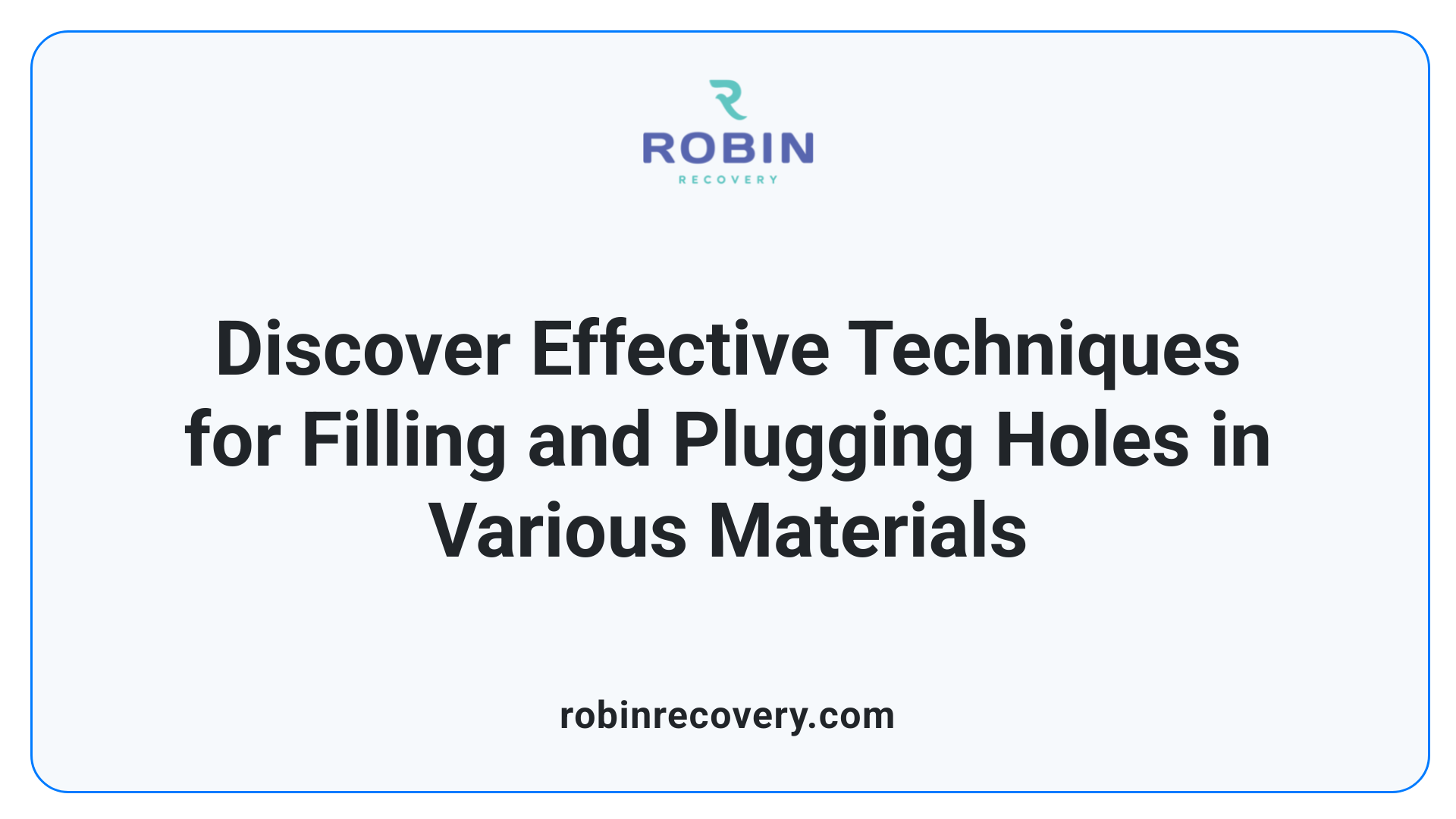Plugging the Hole

Understanding the Significance of Hole Plugging in Various Contexts
The phrase 'plugging the hole' is widely used across different fields, from mechanical repairs to financial management and strategic planning. Whether sealing a physical gap or addressing organizational shortcomings, the core idea remains the same: taking action to fill or fix a problem to prevent losses or further damage. This comprehensive guide explores the literal and figurative meanings of plugging holes, the types of plugs used across industries, effective techniques for filling gaps, and the strategic implications of this practice in business and problem-solving.
Literal and Figurative Meanings of 'Plugging the Hole'

What does the phrase "plugging the hole" mean?
The expression "plugging the hole" primarily means sealing or closing a gap or opening to prevent the escape of substances like water, dirt, or air. For instance, someone may physically plug a leaky pipe to stop water from leaking out. In a broader sense, it also describes addressing problems or deficiencies to prevent further issues.
Metaphorically, "plugging the hole" refers to fixing flaws or gaps in various contexts. This might include plugging a financial shortfall, like covering a budget deficit, or sealing leaks in a system, such as a PR failure or security vulnerability. It symbolizes taking action to prevent loss, damage, or undesirable leaks in less tangible areas like reputation or resource management.
In summary, whether used literally or figuratively, "plugging the hole" involves action aimed at preventing leakage or solving problems efficiently.
Mechanical and Material Perspectives on Hole Plugging

What are the different types, materials, and applications of hole plugs across various industries?
Hole plugs are versatile components used in numerous industries for sealing, protection, and finishing. They come in different types tailored to specific needs. Common types include threaded plugs, tapered plugs, expandable plugs, pipe plugs, and specialized plugs for unique applications.
Materials used for manufacturing these plugs are varied. Plastic options like Low-Density Polyethylene (LDPE), High-Density Polyethylene (HDPE), Polyvinyl Chloride (PVC), nylon, polypropylene, and Thermoplastic Rubber (TPR) are widespread due to their durability and resistance properties. Rubber variants such as EPDM and silicone are selected for high-temperature or chemical-resistant environments. Metals like stainless steel, brass, and aluminum are also used, particularly where mechanical strength and longevity are crucial.
Their applications span many sectors. In plumbing, plugs seal pipelines to prevent leaks. In manufacturing, they close hydraulic and pneumatic systems temporarily or permanently. Construction industries use them to protect openings and prevent debris entry. Electronics and medical laboratories employ specialized plugs to prevent contamination. Mechanical and fitting plugs are essential for system testing, blocking, or sealing openings, maintaining system integrity in oil and gas, transportation, and industrial manufacturing.
What are the properties and considerations for selecting appropriate hole plugs?
Choosing the right hole plug depends on several factors. Environmental conditions such as exposure to chemicals, temperature extremes, and pressure influence material choice. For instance, general sealing tasks often use plastic plugs like nylon or LDPE, while high-temperature environments demand silicone or rubber options.
Size compatibility is vital; the plug must fit the hole precisely to prevent leaks or damage. This involves measuring the diameter of the hole and considering the material's flexibility and strength. Additionally, industry standards and safety regulations guide the selection process.
Ease of installation, reusability, and durability are practical considerations that ensure the plug’s effectiveness over time. Proper selection guarantees that the seal withstands operational stresses, prevents contamination, and maintains structural integrity, ensuring safety and product longevity.
Techniques and Methods for Filling or Plugging Holes in Different Materials

What techniques and methods are used to fill or plug holes in materials like wood or metal?
Repairing holes in various materials requires specific techniques suitable for each type of surface. For wood, small holes can be effectively filled using wood fillers or putty, which are applied directly into the opening and sanded smooth once dried. Larger holes often benefit from inserting wooden dowels or custom-cut plugs, which are glued and hammered into place to restore the structure.
In metal surfaces, stronger fixes are necessary for durability. Epoxy fillers or automotive body fillers like Bondo are popular choices, providing a smooth, long-lasting finish suitable for exposed or load-bearing areas. For structural repairs, methods such as welding fragments or applying sealants like caulk are common based on safety and functional needs.
Pre-made plugs—either plastic, rubber, or wooden—are often used, especially in electrical or plumbing applications. These plugs are inserted into the hole and secured with adhesive to prevent leaks or contamination.
The selection of method depends on size, purpose, and the material of the hole. For fire-rated doors, specialized fire-retardant caulks are used, ensuring safety standards are met while sealing the openings.
How can surface repairs be carried out to conceal holes in ceilings or wood floors?
Concealing holes in ceilings and floors involves surface-mending techniques that restore the aesthetic and structural integrity. In drywall ceilings, the process begins with removing loose drywall paper or debris. Mesh tape is then applied over the patch area to reinforce the bond. Joint compound is spread over the prepared surface, filling the hole and smoothing out any uneven surfaces.
Once dry, sanding creates an even plane that blends with the surrounding ceiling. Painting over the patched area completes the repair, achieving a seamless look.
In wood floors or furniture, small holes are best filled with water-based or elastomeric wood fillers that match the existing color, accommodating natural expansion or contraction. For larger damaged sections, cutting out the compromised part and installing a patch is recommended. Reinforcing the patch with wooden cleats provides extra stability.
Finishing with fine sanding ensures the repaired section is flush and visually indistinguishable from the original surface. Proper finishing techniques, including staining or sealing, further conceal the repair.
Material Type Repair Technique Typical Fillers or Tools Additional Notes Wood Fill small holes Wood filler, toothpicks, glue Match grain direction for better finish Wood Insert plugs Wooden dowels, custom wood plugs Preferrably align grain with original wood Metal Patching or filling Epoxy fillers, Bondo, welding equipment Ensure surface is prepped clean and dry Drywall Seam and fill Joint compound, mesh tape Sand smooth and paint for finish Floor & furniture Fill or replace Water-based wood filler, patches Finish to match existing surface
Selecting the proper technique is crucial for achieving durable and aesthetically pleasing repairs, whether dealing with small cosmetic holes or significant structural gaps.
Polishing and Concealing Techniques for Surface Holes in Artistic and Functional Items

Holes in musical instruments can be effectively repaired and concealed using specific restoration methods to maintain beauty and sound quality. These techniques vary depending on the type of instrument and the material involved.
For wooden instruments, such as guitars or violins, small holes or dents are often filled with specialized wood fillers or plugs. These fillers are carefully matched in color and grain pattern to ensure an inconspicuous blend with the original surface. Sometimes, a small wooden plug shaped from matching wood is inserted into the hole, and then sanded down for a smooth finish.
Plastic and composite instruments may require different solutions. The use of plastic or resin-based fillers that adhere well and are flexible can effectively seal holes or cracks. In more significant repairs, a new section of material might be cut and fitted precisely into the damaged area, then glued and sanded to match the original contour.
Color matching is crucial when concealing holes in musical instruments. Achieving a seamless appearance often involves tinting or staining the filler to match the instrument’s finish. Skilled technicians may also use airbrushing techniques to ensure the repair is invisible.
Before any filling or plugging is done, thorough surface preparation is essential. Cleaning the area, removing any loose debris, and lightly sanding the surface bolster adhesion and ensure a smooth repair. Adequate drying and curing time are necessary to prevent future cracking or pealing.
Instruments with sensitive surfaces, such as those with lacquer finishes, special care must be taken to avoid damaging the original gloss or texture. Temporary patches or decals are sometimes used as a non-invasive concealment method.
Overall, repairing and concealing holes in musical instruments combines material expertise with aesthetic judgment. When done correctly, it restores both appearance and performance, allowing the instrument to look and sound as good as new.
Strategic and Business Aspects of 'Plugging the Hole'

How is 'plugging' used in slang and in a strategic business context?
In everyday slang, "plugging" often means promoting or endorsing something, such as a product, service, or individual. For example, someone might say they are "plugging a new album" or "plugging a charity event," which involves giving it publicity and support. It can also imply actively helping or backing a person or idea, sometimes by sharing information or resources. This casual use of "plug" is about giving a shout-out to gain exposure or support.
In a business or strategic setting, "plugging the hole" takes on a more technical meaning. It signifies identifying and fixing specific issues, vulnerabilities, or gaps that threaten the organization’s stability or performance. Think of it as plugging a leak in a system to prevent data loss, financial shortfalls, or operational failures.
Effective "hole plugging" involves detecting subtle signs of trouble early. Businesses often use methods like root cause analysis, workplace observations, or sense-making frameworks (such as Cynefin) to uncover underlying problems. For instance, fixing a security vulnerability in software before a breach occurs or repairing inefficiencies in a workflow are examples of this proactive approach.
Overall, whether in slang or strategic terms, "plugging" refers to timely intervention—covering gaps to prevent minor issues from escalating into major failures. This concept is crucial for maintaining operational health, security, and long-term success.
Bridging Gaps: The Last Word on Plugging the Hole
Whether in literal physical repairs or strategic organizational management, the concept of 'plugging the hole' embodies proactive problem-solving and effective sealing of vulnerabilities. Knowing the right materials, techniques, and practices ensures durability and success, while a strategic mindset allows organizations and individuals to anticipate issues early and address them efficiently. From sealing pipelines to fortifying business processes, the principle remains: taking action to prevent leaks, gaps, or damages is essential for stability, growth, and resilience in any context.
References
- PLUG A HOLE definition in American English - Collins Dictionary
- plug a hole | WordReference Forums
- Hole plugs, explained | Essentra Components US
- Plugging Holes - American Welding Society
- PLUG THE HOLE - Definition & Meaning - Reverso English Dictionary
- Plugging Holes: Plugs Vs. Dowels - Haze Guitars
- 'Plugging Holes' Is Even More Important For Businesses During the ...
- PLUG A HOLE definição e significado | Dicionário Inglês Collins
- PLUG A HOLE definition in American English - Collins Dictionary
